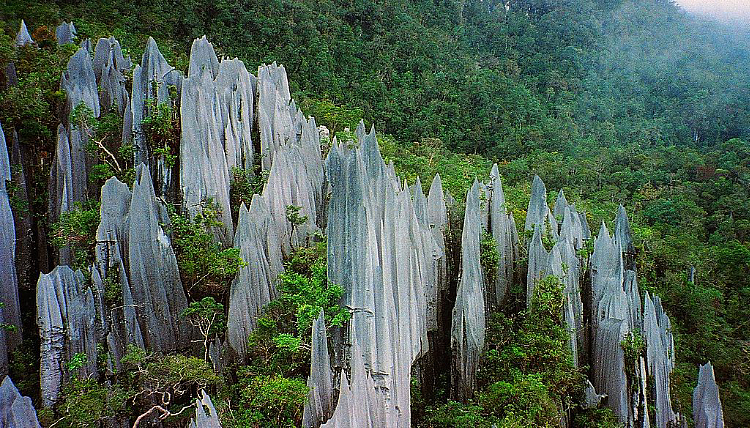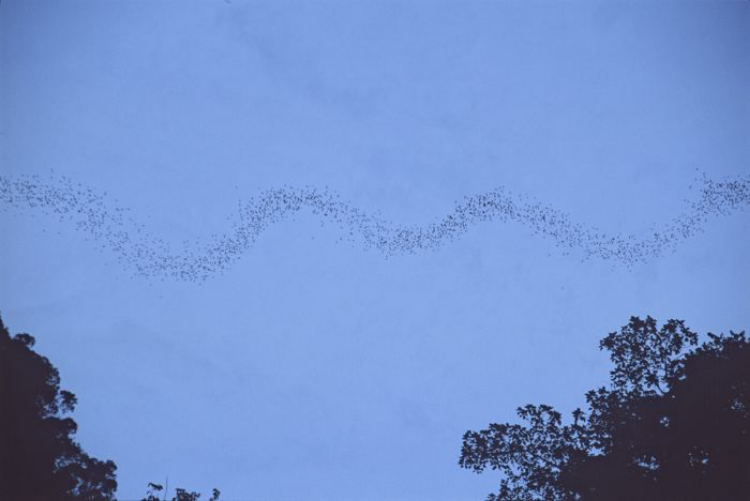Gunung Mulu National Park near Miri, Sarawak, Malaysian Borneo, is a UNESCO World Heritage Site that encompasses caves and karst formations in a mountainous equatorial rainforest setting. The park is famous for its caves and the expeditions that have been mounted to explore them and their surrounding rainforest, most notably the Royal Geographical Society Expedition of 1977–1978, which saw over 100 scientists in the field for 15 months. This initiated a series of over 20 expeditions now drawn together as the Mulu Caves Project
The national park is named after Mount Mulu, the second highest mountain in Sarawak.
Geology and landforms:
Gunung Mulu National Park is famous for its limestone karst formations. Features include enormous caves, vast cave networks, rock pinnacles, cliffs and gorges. Mount Mulu is a sandstone mountain rising to 2,376 m (7,795 ft).
Gunung Mulu National Park has the largest known natural chamber or room – Sarawak Chamber, found in Gua Nasib Bagus. It is 2,300 feet (700 m) long, 1,300 feet (396 m) wide and at least 230 feet (70 m) high. It has been said that the chamber is so big that it could accommodate about 40 Boeing 747s, without overlapping their wings. The nearby Deer Cave is one of the largest single cave passages in the world.
Other notable caves in this area are Benarat Cavern, Cave of the Winds, and Clearwater Cave, the 8th longest cave in the world (May 2014) and believed to be the largest cave in the world by volume at 30,347,540 m³.
Mulu’s limestones belong to the Melinau Formation and their age is between 17 and 40 million years (Late Eocene to Early Miocene).
Stratigraphically below the limestones, and forming the highest peaks in the south east sector of the Park including Gunung Mulu, lies the Mulu Formation (shales and sandstones). The age of these rocks is between 40 and 90 million years (Late Cretaceous to Late Eocene).
Fauna:
Eight species of hornbill have been spotted in Mulu including the Rhinoceros Hornbill Buceros rhinoceros which features on Sarawak state emblem, the White-crowned Hornbill Berenicornis/Aceros comatus and the Helmeted Hornbill Buceros vigil with its large solid casque (bill).
Twenty seven species of bat have been recorded in Mulu. Deer Cave in the southern limestone hills of the park is home to an enormous colony of Wrinkle-lipped bats (Tadarida plicata). The bats exit the cave almost every evening in search of food in a spectacular exodus. A huge mound of guano in the cave is evidence of the size of the bat colony that roosts in the cave’s high ceilings.
Mulu’s mammals also include the Bearded pig Sus barbatus, the moonrat Echinosorex gymnurus, shrews, the Bornean Tarsier Tarsius bancanus, the long-tailed Macaque Macaca fascicularis, gibbons, squirrels, and three types of deer including the small barking deer and mouse deer. The small Malaysian sun bear Helarctos malayanus, which is the only bear known in South-East Asia, has also been identified in Gunung Mulu National Park.
How to reach:
Mulu National Park is a very remote access area; the only practical way of getting to and from it is by air, through Mulu Airport. There are flights between Mulu Airport and Miri, Kuching and Kota Kinabalu with MasWings. Alternatively, it is possible to travel by river from Miri, which is about 100 km away, using a riverboat, then a chartered long boat, which in total takes around 12 hours. Before the opening of the airport and the opening of a helipad in 1991, this was the only way to reach the national park.
Excursions to Mulu continues to retain the sense of adventure associated with its original exploration through the provision of adventure caving and other adventure activities. The primary focus, however, has shifted to the promotion of an awareness of the significance of the park and its environment through the provision of ecotourism activities that foster understanding and appreciation of the parks values.


